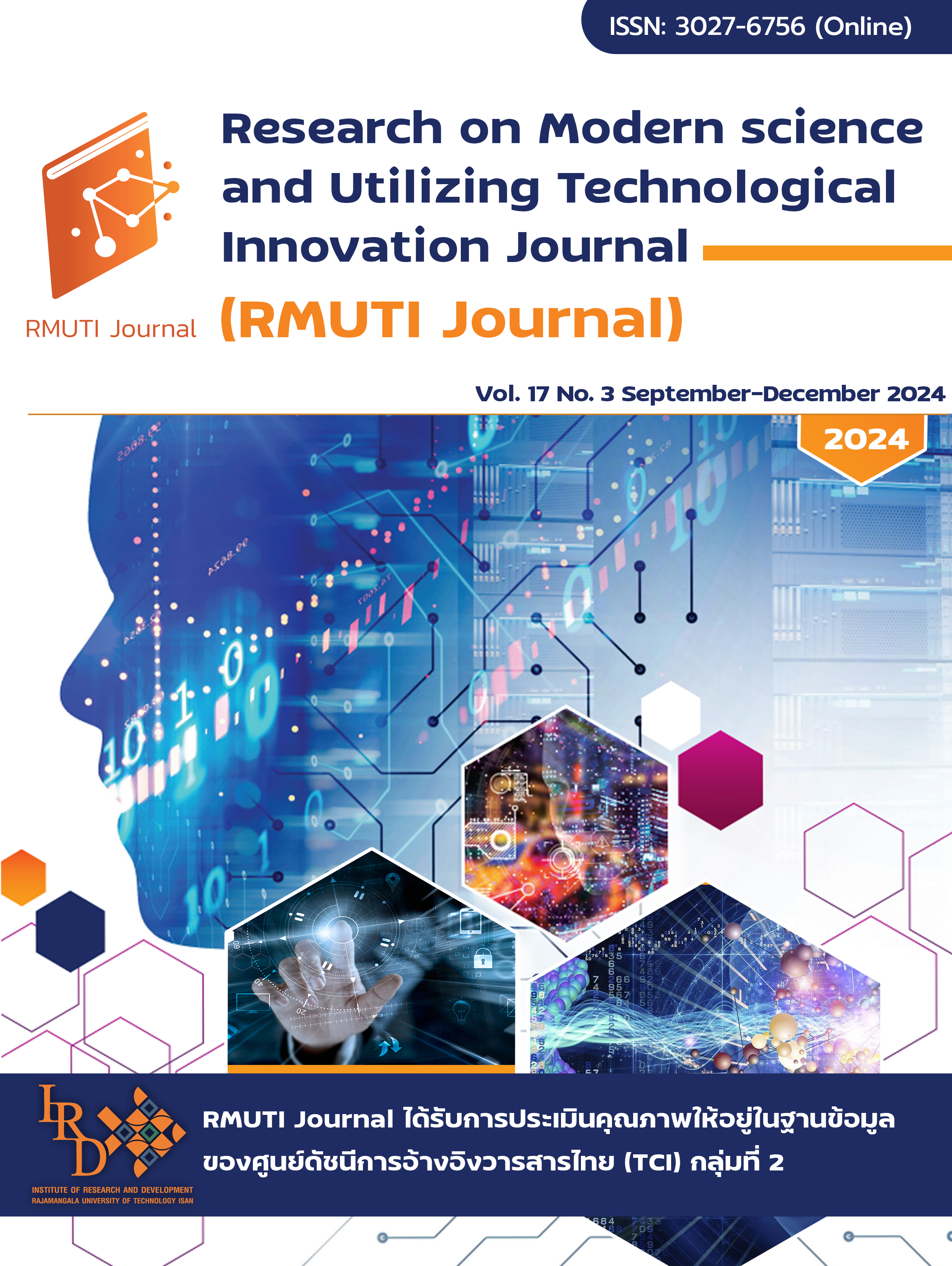การศึกษาหาพารามิเตอร์ที่เหมาะสมในการตัดวัสดุเหล็กเหนียวด้วยเครื่องตัดพลาสม่า
Main Article Content
บทคัดย่อ
บทความนี้กล่าวเกี่ยวกับกระบวนการตัดเหล็กแผ่นเกรด SS400 ซึ่งเป็นเหล็กโครงสร้างที่ใช้กันอย่างแพร่หลายยกตัวอย่างเช่น งานก่อสร้าง งานสะพาน งานอุตสาหกรรมยานยนต์ เป็นต้น ผู้วิจัยจึงได้ศึกษาการตัดเหล็กเกรด SS400 ด้วยเครื่องตัด Thermatech รุ่น TM1634 โดยตัวแปรที่พิจารณามีดังนี้ 1) แรงดันลม 2) ระยะห่างระหว่างหัวตัดชิ้นงาน และ 3) อัตราเร็วในการตัดถูกกำหนดเป็นตัวแปรที่ใช้ในการศึกษานี้ ชิ้นงานขนาดความกว้าง ความยาว และความหนาเป็น 50 50 และ 5 mm ตามลำดับ โดยทำการบันทึกค่ากระแสไฟฟ้า และค่าความหยาบผิวเฉลี่ย (Ra) ออกแบบการทดลองโดยใช้ Orthogonal Array ด้วยวิธีทากูชิ จากการทำนายค่าที่เหมาะสมที่สุด กรณีค่าน้อยยิ่งดี (Smaller-the-Better) สรุปได้ว่า ในการตัดเหล็ก SS400 ด้วยเครื่องตัดพลาสม่า ยี่ห้อ Thermatech รุ่น TM1634 โดยใช้ค่าแรงดัน 5 bar ค่าระยะห่างของหัวตัด 35 mm ความเร็วในการตัด 150 mm/s จะใช้กระแสไฟฟ้าเท่ากับ 20.98 A ในส่วนของค่าความหยาบผิวที่เหมาะสมที่สุดมีค่าเท่ากับ 9.76 µm โดยใช้ค่าแรงดันลม 5 bar ค่าระยะห่างของหัวตัด 40 mm ความเร็วในการตัด 250 mm/s
Article Details

This work is licensed under a Creative Commons Attribution-NonCommercial-NoDerivatives 4.0 International License.
References
Sato, M. (2017). A Study of Parameters that Effect to Wear of Plasma Nozzle Made from Cutting Low Carbon Steel IRSM-41. Master of Engineering Thesis, Department of Industrial Systems and Environmental Engineering, Suranaree University of Technology (in Thai)
Chatmuangpak, A., Wongwian, C., and Kangsantia, S. (2003). Experimental Design Using the Taguchi Method for Determining the Optimal Parameters of the Cutting Process by Wire Cutting Machine. Thai Industrial Engineering Network Journal. Vol. 9, No. 2, pp. 66-74 (in Thai)
Bangphan, S., Bangphan, P., Nangmor, N., and Chantathi, P. (2016). Application of Taguchi Method for Optimizing Shaft Work Piece Assembly Turning Process by the Effects of Machining Parameters. UBU Engineering Journal. Vol. 9, No. 1, pp. 1-10 (in Thai)
Ruksorn, P. and Deepradit, S. (2019). The Prediction of Surface Roughness in the S45C Medium Carbon Steel Turning Process by Using Response Surface Methodology. Thai Journal of Operations Research. Vol. 7, No. 2, pp. 13-19 (in Thai)
Charoenrat, S., Pookamnerd, Y., and Prasomthong, S. (2022). Optimization of Medium Carbon Steel Welding Joint by Hot-Wire Gas Tungsten Arc Welding Using the Taguchi Method. Journal of Industrial Technology Ubon Ratchathani Rajabhat University. Vol. 12, No. 2, pp. 43-55 (in Thai)
Krishankant, Taneja, J., Bector, M., and Kumar, R. (2012). Application of Taguchi Method for Optimizing Turning Process by the Effects of Machining Parameters. International Journal of Engineering and Advanced Technology (IJEAT). Vol. 2, Issue 1, pp. 263-274
Timata, M. (2021). Optimization on P20-steel Taper Cutting with Wire Electrical Discharged Machine. SAU Journal of Science & Technology. Vol. 7, No. 1, pp. 15-21 (in Thai)
Hantang, S., Khanthirat, W., Lawong, A., Warorot, W., and Sudsuansee, T. (2023). Optimizing the Surface Roughness of ST37 Steel using CNC Turning Machinery through the Taguchi Technique. Journal of Engineering and Industrial Technology, Kalasin University. Vol. 1, No. 5, pp. 27-39 (in Thai)
Namkaew, S. and Prasomthong, S. (2021). Application of Taguchi Method for Burnishing Process of AA5052 Aluminum Alloy by Studying the Optimization of Production Machining Parameters. The Journal of Industrial Technology. Vol. 17, No. 1, pp. 82-94 (in Thai)
Eiamsa-ard, K., Chaipukdee, N., Boonlerdcharoensak, N., Liou, F., Raksiri, C., and Rodkwan, S. (2007). Taguchi Method for Material Deposition Process using LASER. In Proceedings of the 21th Conference of the Mechanical Engineering Network of Thailand (ME-NETT 21). Chonburi, 17-19 October 2007

